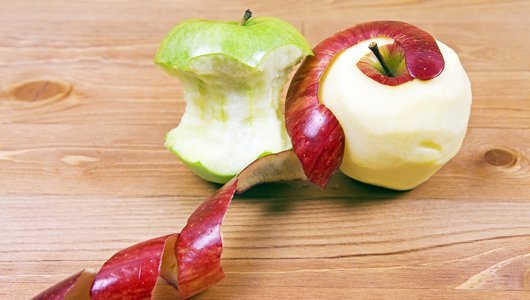The peels of many fruits and vegetables contain valuable nutrients and by tossing the peel, you’re tossing fiber and nutrition, too. The peels of apples, pears and most fruits with pits add interesting texture to recipes and contain valuable nutrients and fiber. What’s more, some fruits and veggies have their best attributes “on the outside” and are recommended to be consumed with their skins:
- Apple peels contain 2-6 times more nutrients and insoluble fiber than the apple flesh;
- The hairy skin of kiwis contains anti-inflammatory and anti-allergenic properties and has 3 times the antioxidants as the pulp;
- Watermelon rind is even a better example as it contains more vitamin C, B6 and the amino acid citrulline, which dilates blood vessels to improve circulation, than the sweet flesh inside;
- Orange and lemon peels contain higher levels of vitamin C than the flesh and, incredibly, twenty-times the antioxidants. The white pith under the skin is high in pectin, a necessary fiber component known to help lower cholesterol and promote growth of beneficial gut bacteria;
- Banana peels can help ease depression due to their rich serotonin content and are full of the antioxidant lutein, a compound that helps protect our eyes from UV light (and thus against cataracts);
- Potato and sweet potato skins are loaded with fiber and nutrients like vitamin K, potassium, copper and iron;
- The deep purple hue of an eggplant’s skin should definitely not be removed! Eggplant skin contains an antioxidant called nasunin that is a potent free radical scavenger and helps fight cancer and protect cell membranes from damage.
[adinserter block=”2″]
 Consuming fruits and vegetables with their skin is also a good way to give your body some cancer protection.
Consuming fruits and vegetables with their skin is also a good way to give your body some cancer protection.
With all of these benefits, surely we should just go ahead and eat our peels, right? Not so fast, the bad news is that the peel can also be contaminated with pesticide residue, dirt and antibiotic-resistant bacteria. More bad news: purchasing organic produce does not automatically buy you contaminant free food. Even organic foods can carry organic fertilizer residues as well as dirt and bacteria.
However, choosing organic produce may help minimize your exposure to pesticide residues. A report from 2010 from the U.S. Department of Health and Human Services, “Reducing Environmental Cancer Risk: What We Can Do Now ,” recommends that “individuals reduce their environmental cancer risk by choosing, to the extent possible, food grown without pesticides or chemical fertilizers.” The report also recommends “washing conventionally grown produce to remove residues.” However, conventionally grown produce contains residues that cannot be completely removed by washing.
[adinserter block=”3″]
The safest way to enjoy whole fruits and vegetables may be by buying organic and then carefully washing. “Produce handling should always start with washing, beginning with your hands” says Helen Rasmussen, a senior research dietitian at the Jean Mayer USDA Human Nutrition Research Center on Aging. “Rinse all fresh produce under running water; you can also rub the food with your hands or a soft, clean brush. Be sure to wash around the stem or blossom ends where germs collect. Pay attention to bruised or damaged areas, where bacteria can thrive. Cut these areas out, and rinse the flesh.”
Her statement also to echoes the guidance for handling and preparation of produce from the HHS and FDA:
- Cut away damaged or bruised areas;
- Wash all produce (conventional or organic) thoroughly under running water before eating, cutting or cooking;
- Soap, detergent or commercial produce washes are not recommended;
- Scrub firm produce, such as apples, potatoes or squash, with a clean produce brush;
- Dry all produce with a clean cloth or paper towel.
[adinserter block=”4″]
To peel or not to peel?
Before deciding, know the food you are buying. Is it organic and from a source you trust? If yes, make sure to wash nicely and feel free to consume it whole, with all of its precious nutrients. If buying conventional produce from a dubious, or unknown origin, don’t risk it, just peel the skin off. Most of the time however, we don’t have enough info on the origin and conditions in which the produce was grown, so make sure to follow the washing instructions by the HHS and FDA thoroughly and don’t take any chances – cut away damaged or bruised areas or anything looking suspicions. If you notice unnatural shine or a waxy, sticky feel on touching, better cut away. Afterwards wash again whatever is left of the skin before eating. Of course, it also depends for whom the meal is intended. When preparing the meal for children be extra cautious and take less chances.
At the end of the day, the peel of fruits and vegetables is an integral part of the product and if we take some care when shopping and handling the benefits outweigh the risks and we can enjoy them as nature intended – in all of their magnificence.

